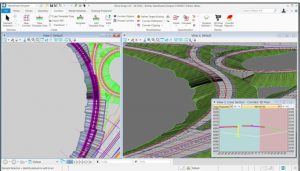

First set the active element template to Corridor. Open a Corridor dgn and use the Corridor Modeling Tasks to Create the design.This will attach the profile to the Horizontal Geometry and create the 3D Alignment Features. When finished designing, save the dgn then set the profile to be active.It is advisable to Save Settings and Save prior to starting a profile. Set the Active Terrain model first then use the Vertical Geometry Tasks to Create the Profile.Use the Horizontal Geometry Tasks to create the alignment in the Geometry drawing.Drawing file names and how they are referenced is important and is documented in Create Project DGN's.Ī simplified outline of alignment and corridor design steps with links to more in-depth explanations of the Tools follows: OpenRoads works within MX using the Civil Tools to perform all the roadway design steps. Road Design - Corridor - Corridor Templates Creating the features from TOPO model - Importing MX StringsĪ Linear Feature Definition controls how the feature is displayed in 2D plan, profile, section, and 3D view and how it interacts with various tasks.įull details are included in Feature Definitions.Create the DGN and Terrain - Create Terrain from Triangles.This is an outline of the 3 step process. In the future, the terrain model will be created by Plan Prep, but for now it will be created from the MX TOPO and TRIANGLES models. In SS3 & SS4 Design, a Terrain Model is created for the existing surface. When complete, select OK to apply these changes. entry Select the cell file, Right-click on it anvb hit delete to delete it. Deleting the cell file by clicking on the.

This needs to be deleted so the MX mapping table will find our MicroStation Cells instead of creating them from macro symbols. The following seed files should be used when working in SS3 or SS4 (see below). Use the View Group > Multi-Model Views to display.
#Open roads designer windows
Individual Windows can have a view of the 3D information even when in the Default 2D model. So you are really seeing all the information in the dgn when you look at the Default Model.

The Default model has the Default-3D model attached with live nesting which has the MX model attached to it with live nesting. MX Models and strings will only be displayed in the MX model. Work should be done in the Default model unless otherwise stated. Pay Attention to the MMD you are using and only use an MMD created for SS4 projects when working in SS4! Civil DGN Files and ModelsĪ typical Civil DGN has 3 models in it a 2D Default model, a 3D Default-3D model and a 3D MX model.

If this choice is not available, contact your CAD/D administrator. Make sure you select US_Imperial for the Default MX Project Settings. In the case of a project covering multiple towns, the first one in the project name is used. NHDOT practice is to create a folder for the project under a folder for the town. Road Design - Corridor - Corridor Templatesīefore starting work on any project, a directory must be created to store the data.Whether you need to produce traditional 2D deliverables, advance to 3D modeling, support digital transformation, or all the above, OpenRoads is the choice for road design.Much of this information is still applicable in MX SS4 Start with real data, and create accurate, georeferenced 3D designs with real-world context through the seamless integration of reality data and design information. Reduce highway design time with a complete toolset for survey, drainage, utilities, and roadway detailed design in one application. You Don’t Work in a Silo and Neither Should Your Softwareįrom integrating existing conditions to working with other project partners, OpenRoads’ model-centric approach makes it easy to work with different data types, disciplines, and distributed teams.OpenRoads Designer is a comprehensive and fully functioned detailed design application for surveying, drainage, subsurface utilities, and roadway design that supersedes all capabilities previously delivered through InRoads, GEOPAK, MX, and PowerCivil.


 0 kommentar(er)
0 kommentar(er)
